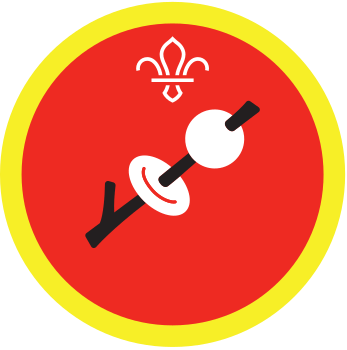Try using a flint and steel
You’ll need
- Fire steel
- Cotton wool pads or balls
- Fire bucket, filled with water
- Jar lids or small foil trays
- Materials to make fire lighters
- Newspaper
- Kindling and fire wood
- Ingredients and utensils to cook (optional)
Before you begin
- Use the safety checklist to help you plan and risk assess your activity. There's also more guidance to help you carry out your risk assessment, including examples.
- Make sure all young people and adults involved in the activity know how to take part safely.
- Make sure you’ll have enough adult helpers. You may need some parents and carers to help if you’re short on helpers.
Planning this activity
- You could run this session as two bases – this may be helpful if you don’t have a lot of space or equipment.
- At one base, people could use fire steels to light a small fire.
- At the second base, people could prepare a quick snack to cook on a fire (or barbecue) that adult volunteers have prepared. If you do this, make sure you have a system to remember whose food is whose so it doesn’t get mixed up.
- Before the session, you could make a circle of spread-out piles that contain a fire steel, foil tray or jar lid, and cotton wool ball or two.
- Prepare the materials people will need to make firelighters – we’ve included some suggestions on this page. It’s up to you whether everyone makes the same one or whether the group tries a few different types.
Catch a spark
- The group should go to or collect a pile of fire lighting equipment.
- An adult explain and demonstrate to everyone how to use the fire steel and create a spark safely, using the below method.
- The fire steel has two parts: the rod and the striker. People can hold them in either hand, depending on whether they’re right or left-handed.
- People should kneel down with their back facing the wind and keep their knees together. This eliminates any draughts.
- Everyone should pull their cotton wool apart, so that it’s really fluffy, and place it into the foil tray.
- With adult supervision, people can take it in turns to grip their steel rod with their thumb on top and the side of their index finger below. They should hold the striker the same way. They should hold the striker above the rod at a 90-degree angle.
- Carefully feel the edge of the striker with your finger. The sharper edge should point down to scrape the rod.
- Everyone should put the tip of their rod onto their cotton wool ball. They should try to get the fire steel as close to the tinder as they can to help guide the sparks to the target.
- Now, tilt the striker to a 45-degree angle and scrape down the rod slowly, adding pressure to create sparks. Always move in a direction away from the body.
- Keep trying until the sparks catch the cotton wool on fire. It should burn out in a couple of seconds.
- People can practise again with another cotton wool ball, until everyone has managed to light at least one fire.
Make some fire lighters
- Choose what type of firelighter the group should make from the following options:
- Stuffed toilet roll tube: stuff a cardboard toilet roll tube with cotton wool, wood shavings or dried grass. Squeeze or fold over the ends to stop the filling coming out.
- Jelly cotton wool: smear petroleum jelly on cotton wool balls. Petroleum jelly isn’t flammable until the cotton wool heats it up, so it makes the firelighter last much longer.
- Stuffed egg box: tear newspaper into thin strips and stuff them inside a cardboard egg box.
- Crisps: use tortilla chips – they burn well because of the fat in them.
- Newspaper tubes: roll newspaper into a tube shape, flatten it and tie a knot (or fold it) in the middle.
- Give everyone the equipment they need to make the chosen firelighter.
- Explain and demonstrate how to make the firelighters, then everyone can give it a try with adult supervision.
Build a fire
- Let everyone find a space to build their fire. People could work in pairs or smaller groups.
- Everyone should collect some kindling.
- Next, they should put the firelighter they made earlier into the centre of their space. Use the kindling to build a fire structure around it.
- Like before, everyone should kneel by their fire with their back to wind and knees together. They should use the fire steel to light their fire by placing the rod next to the fire lighter and striking like they practised.
- If people have made different firelighters, you can test them out to see which works best. People may want to take it in turns so they can watch other people use their firelighters.
- Once the sparks have caught, everyone should gently blow on the flame or spark. This'll help to provide more oxygen to grow the flame.
- Everyone should begin to slowly add bigger and bigger pieces of kindling, then pieces of wood, to establish the fire.
- Tell people to let the wood burn for a few minutes. This would be the perfect time to prepare a snack, as glowing coals are the best for cooking on. You could try making our Sausage smash recipe, Pitta pocket pizzas or try making Damper snakes. You may want to keep it simple and just make s’mores.
- Once everyone’s cooked their snack, an adult should safely and fully extinguish the fires.
Reflection
This activity gave everyone a chance to practise their skills and keep on going when things got tricky. Do people usually light fires on their own. People may be used to working in groups – how did it feel to go it alone? Did people’s fires work perfectly first time? It’s OK if it took a little while to get the hang of the fire steel or to make the perfect firelighter. What helped people to stick at it when things went wrong? How did it feel?
Safety
All activities must be safely managed. You must complete a thorough risk assessment and take appropriate steps to reduce risk. Use the safety checklist to help you plan and risk assess your activity. Always get approval for the activity, and have suitable supervision and an InTouch process.
- Cooking
Teach young people how to use cooking equipment safely. Supervise them appropriately throughout. Make sure it’s safe to use and follow manufacturers’ guidelines for use.
- Fires and stoves
Make sure anyone using fires and stoves is doing so safely. Check that the equipment and area are suitable and have plenty of ventilation. Follow the gas safety guidance. Have a safe way to extinguish the fire in an emergency.
- Food
Remember to check for allergies, eating problems, fasting or dietary requirements and adjust the recipe as needed. Make sure you’ve suitable areas for storing and preparing food and avoid cross contamination of different foods. Take a look at our guidance on food safety and hygiene.
- Flammable items
Always take care when using flammable items, especially if you’re near fire. Always follow the manufacturer’s instructions and guidelines.
- Sharp objects
Teach young people how to use sharp objects safely. Supervise them appropriately throughout. Store all sharp objects securely, out of the reach of young people.
- Outdoor activities
You must have permission to use the location. Always check the weather forecast, and inform parents and carers of any change in venue.
Why not try out different fire lighters or different fire structures in this activity? You could challenge everyone and see who can be the first to light their fire and boil some water.
If you’re cooking campfire snacks, check if anyone in the group has any allergies or dietary requirements. You could swap chocolate buttons for dairy-free chocolate buttons or use gluten-free pitta breads, for example.
If anyone struggles using the fire steels, think about alternative ways they could light their fire, for example, matches or simple electric lighters.
All Scout activities should be inclusive and accessible.

